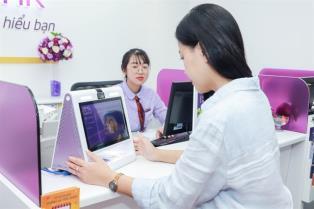SBV's deputy governor Phạm Tiến Dũng said as the number of customers and transactions increases, the rising complexity poses many challenges for managing and ensuring security in the payment industry.

The average annual growth in the number of transactions via QR code has reached 471.13 per cent since the payment method's introduction in 2018, 77.41 per cent of the Vietnamese adult population possess payment accounts with commercial banks reporting over 90 per cent of all transactions conducted through digital channels, with some banks achieving a rate of up to 98 per cent, according to the State Bank of Vietnam (SBV).
In terms of transaction volume, while there were approximately 700 million transactions in the clearing and settlement system in 2019, a figure considered ambitious at that time, by 2023, the number of transactions had reached 7 billion, a tenfold increase from 2019.
In comparison to 2017 with just a few banks implementing mobile banking, all transactions can be processed on mobile platforms, offering customers unprecedented speed and convenience. Previously limited to banking activities, now users can perform various tasks such as booking flights, selecting seats, ordering taxis and paying utility bills through banking apps.
Payments via the Internet, mobile and QR codes have seen a period of rapid growth. Currently, 85 organisations provide payment services through the Internet, and 52 organisations offer mobile payment services. Average annual growth in the number of transactions through Internet and Mobile payments is 46.48 per cent and 90.12 per cent, respectively. QR code, in particular, has seen an average annual growth in the number of transactions reached 471.13 per cent since 2018.
However, SBV's deputy governor Phạm Tiến Dũng said as the number of customers and transactions increases, the rising complexity poses many challenges for managing and ensuring security in the payment industry. Challenges include the growth in the number of accounts associated with issues such as using fake documents to open payment accounts, individuals opening accounts and then selling them to others, and engaging in illegal transactions. There are also risks related to the security of the payment system. Therefore, ensuring security becomes a crucial task as many banks have exceeded the 25 million customer mark.
Regarding measures to bolster payment security, Phạm Anh Tuấn, head of the Payment Department under the SBV, said the central bank has been working closely with the Ministry of Public Security (MPS) and other Government agencies to implement steps to prevent and minimise the risks of fraud, deception and loss of payment.
As a result, 42 million customer records have been screened and cross-referenced with another 6.5 million recorded in processing by the end of 2023.
As many as 48 credit institutions have contacted the MPS to exchange data cleaning plans. Fifty-three credit institutions are coordinating with enterprises licensed by the MPS to provide user authentication solutions, using chip-embedded citizen identity cards, with nine credit institutions already implementing this solution.
According to a representative from the MPS, after eight months of implementation, the basic tasks have been carried out in line with the directives of the leaders of the Ministry of Public Security and the State Bank, focusing on cleaning up customer data, applications of chip-embedded citizen identity cards, and VneID accounts for user verification and customer identification, contributing to supporting crime prevention efforts and fraud prevention in payments.
A representative from Vietcombank said that they have completed eight out of 11 tasks in 2023. In 2024, Vietcombank will continue to upgrade and expand the scope of applications both at the counters and through electronic channels.
In addition, the bank has plans to use VneID for user authentication and updating customer information, opening accounts, and registering products and services through the VNeID app, as well as opening accounts and registering enhanced products and services on VCB Digibank.
A representative from VietinBank stated that the bank has collected more than 6 million biometric data of customers through the eKyC account opening process, as well as through biometric data collection on phones and at the counters. — VNS





